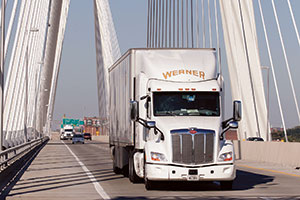Fleets, Shippers Battle on Rates While US Economy Downshifts

MIAMI — The softening U.S. economy is putting pressure on cost-conscious shippers to hold the line on freight rates this year, setting the stage for a tough battle with carriers seeking further rate increases to cover their own rising costs, such as driver pay.
That was the key message from speakers at the Stifel, Nicolaus & Co. and BB&T Capital Markets freight conferences here last week. As the trucking industry’s cycle of annual rate negotiations accelerates, carriers’ rate increase expectations have reached as high as 5%.
“[Freight] feels soft,” said Jeff Silver, CEO of Coyote Logistics, the truck brokerage specialist acquired by UPS Inc. last year. “We are in a lull. In conversations with our customers, big shippers are not expecting to give rate increases.”
UPS ranks No. 1 on the Transport Topics Top 100 list of U.S. and Canadian for-hire carriers.
Al Kent, a director of transportation at The Home Depot, said he expects freight rates will rise “somewhat less than 1%.”
Brian Reed, executive vice president at Niagara Bottling, went further, answering “below zero” when asked how much of a rate adjustment that California-based Niagara, which sells private-label bottled water, wants to see this year.
Other freight buyers in private conversations indicated that annual contract rates so far this year have ranged between unchanged and 1%.
That is a far cry from this time last year, when truckload rates rose about 6% in the first quarter compared with 2014, as measured by Cass Truckload Index.
“The battle over [rate] growth is going to be hard-fought,” Stifel analyst David Ross said. “Usually, these things wind up in the middle. That is why our view is that rates are going to improve 2% to 3% overall.”
From the carrier side, Saia Inc. CEO Rick O’Dell said he anticipates rate increases averaging 4%, saying that goal was part of an ongoing “fine-tuning” of rates. Saia ranks No. 26 on the for-hire TT100.
Some fleets with a brighter view of freight markets also are forecasting increases linked to their customer base.
Derek Leathers, president of No. 16 Werner Enterprises, said he was comfortable that rates can rise 2% to 3%, continuing an upward trajectory for an eighth consecutive quarter at the consumer products-oriented fleet.
“Freight is nearer equilibrium than some people might think,” Leathers said, and is similar to historical trends seen in 2011 through 2013.
“Freight is not bad,” said David Parker, CEO of Covenant Transportation Group, No. 46 on the for-hire TT100. “It’s just not where we want. It wouldn’t take much for us to say freight is good.”
Parker is seeking 3% to 5% rate increases as markets for key customers, such as organic food, continue to be strong.
Richard Stocking, president of No. 6 Swift Transportation, anticipates raising rates 2% to 3% on top of the 4% achieved last year.
Stocking’s expectations were linked to the gradual resolution of a long-standing inventory glut, which has been cited by experts such as American Trucking Associations Chief Economist Bob Costello as a key reason for the weaker freight market.
Stocking said he’s excited about the potential for economic growth from the consumer sector as Americans’ wages increase.
While fleets face a squeeze on profit margins if rates don’t increase, pressure on their largest expense — driver pay — isn’t likely to abate, Parker and others said.
Driver pay “is going to continue to increase along the same lines in the future,” said Parker, whose fleet has raised wages a total of 20% over three years. He added that Covenant hasn’t decided on 2016 driver pay adjustments and that increases might not happen if there is no growth in freight markets.
Gordon Klemp, whose National Transportation Institute assesses driver compensation at more than 300 truckload fleets, said wages will rise about 4% this year if gross domestic product growth is 2.5%.
“If the U.S. slides back and GDP growth is under 2%, we will have a very slow year in wages, maybe a 1% to 1.5% increase,” Klemp said.
Wage trends are tracking the drop-off in freight, he added. Last year, driver pay rose an average of 6.8%, but the number of fleets making raises fell sharply in the fourth quarter.
Kent, Reed and Kevin Jones, vice president of inbound transportation at Wal-Mart Stores Inc., were careful to offer a broader perspective on rates.
Kent and Reed said they were concerned about future freight capacity, which affects rates.
“Rates are important,” Jones said. “We are not saying that isn’t the case, but there is a whole portfolio of things we talk about with carriers. We have the opportunity to talk about lifestyle and building the kind of routes that you can run and get drivers home” to help with retention.
Jones didn’t give a percentage change in rates.




